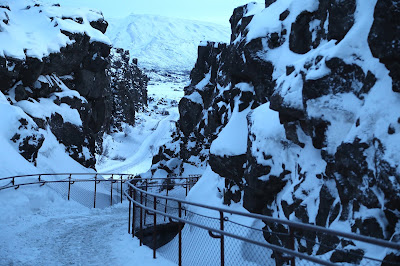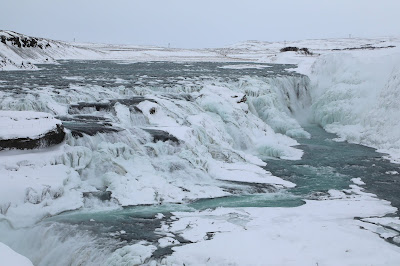We woke this morning to much better weather and some open roads. We decided to head out nice and early. Iceland has a travel site where you can register your driving trip, as well as up to date weather and road closures. I must admit I was somewhat obsessed in watching the site hoping for good weather and roads.
In Iceland there have been several times where visitors get caught out stranded on closed roads and the local Search and Rescue teams become very very busy.
Our first stop is Thingvellir National Park which is an amazing site, steeped in history and folklore and surrounded by incredible geology. It has the honour of being the first national park to be established in Iceland. It is also the only one that has been granted UNESCO World Heritage status.
The roots of both how this island formed (geologically) and how its civil society was created can be found here at Thingvellir.
The incredible geology of the park comes from the fact that it is situated directly on the North American and Eurasian tectonic plates, in the rift valley that runs all the way through Iceland. This is the only country where this valley, the Mid-Atlantic Ridge, can be seen above sea level. Nowhere is it more visible than here at Thingvellir National Park.
We entered the park from Reykjavik, here a sheer cliff that is, in fact, the corner of the North American continent. It was a pocket of magma which formed between these plates and rose as they moved apart that is responsible for the creation of Iceland millions of years ago.Their continued separation is the reason that Iceland has such fascinating volcanic activity. The island is still very young, and still very much in the process of formation.
The incredible location and fascinating geology of Thingvellir, however, have nothing to do with why it received National Park and UNESCO World Heritage Site status. The first permanent settlers to Iceland came in the 800s and were largely vagabond clans who refused to bend a knee to the new High King of Norway.
In 930 AD, however, they decided that some sort of collective government could ease disputes on the island, and each of the thirty or so groups present sent someone to represent them.
They deemed their meeting place ‘the fields of parliament’, which translates to Thingvellir
Our next stop on the Golden Circle Route is Geysir. This is the earliest documented geyser in European literature, and its name comes from the Old Norse verb ‘to gush’, geysa.
Geysir rarely erupts but its neighbour, Strokkur, goes off every ten minutes or so, throwing water from 20 to 40 metres (66 to 132 ft) into the air.
The reason the original Geysir is mostly inactive these days is because of the tectonic activity in the area, as well as intrusive human intervention.
Studies show that it has existed for about 10,000 years and that it tends to erupt in cycles. Usually, a large earthquake will trigger it to start off, then it will slowly peter out over time.
Even when it is erupting, however, it is unpredictable in its timing and consistency. For example, in the early 1910s, it was known to erupt every half an hour, yet its activity had almost ceased altogether by 1916.
The next stop is a fairly short drive from Geyser to Gullfoss. A strong cold wind greets us in this beautiful location.
Gullfoss is not only known for its breathtaking power but also for the rainbows that arise from its spray on a sunny day. We did not have any sunshine at all, yet if you visit on a sunny day you might get lucky.
Like with the springs in Thingvellir and the water at the Geysir Geothermal Area, the river that flows down Gullfoss comes from Langjokull glacier. The name of the river is Hvita.
In the early 20th Century, foreign investors saw a huge amount of opportunity in adding a dam to Gullfoss and turning it into a hydro-electric plant. The owner of the falls at the time, Tomas Tomasson, had indirectly loaned outsiders the right to do what they wanted with it. These plans, against his wishes, started to go ahead; but were incredibly difficult to enforce with Tomas’ daughter in the picture.
This iconic woman, called Sigridur Tomasdottir, refused to let the natural wonder she loved so much be destroyed. She did everything she could to preserve it; from threatening to throw herself into the falls, to walking the 200 kilometres of unpaved road to Reykjavik and back again multiple times to rally a legal case in Gullfoss’ defence.
Although her actions did not directly save the waterfall, they drew attention to the case. This led to national criticism of the plans and ensured that the process of adding the dam was delayed.
Eventually, the lawyer she enlisted in her protests managed to work with the investors (who were lacking in money to take action) to persuade them to annul the contract.
This lawyer, Sveinn Bjornsson, may sound familiar. He was the same man who was chosen as Iceland’s first president.
From Gulfoss we made our way back to Reykjavik, through blowing snow, snow and ice packed roads. Just like here in Wyoming, there was always the chance of a road closing and dashing our hopes of making it back.
This evening the skies started to clear a bit and the possibility of seeing the Aurora see like a possibility. So at about 9:00 we drove out to the Light House and did get a quick glimpse of the Aurora. The clouds rolled in and we called it a night.

















No comments:
Post a Comment